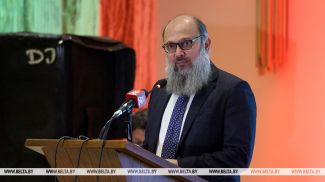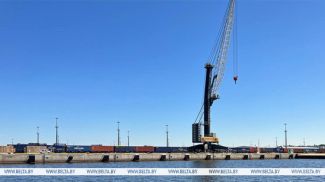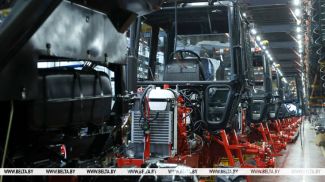Over 5,000 people are now employed at the construction site of the Belarusian nuclear power plant. The construction workers can be seen virtually at all the facilities of both power-generating units. The installation of the main equipment of the turbine hall and the reactor hall has begun in the first power-generating unit. The “nuclear heart” of the installation travelled for virtually 2,500km by water and by land all the way from the manufacturing factory in Russia to Ostrovets in late 2016. The state enterprise Belarusian Nuclear Power Plant reported earlier that during transportation the protective shroud of the reactor pressure vessel touched a contact-line mast yet the experts found no fault with this piece of hardware once the product was delivered to the construction site. Representatives of the enterprise Belarusian Nuclear Power Plant made it clear they have nothing to hide and allow filming and taking pictures of the reactor pressure vessel. What is going on right now at the construction site near Ostrovets is covered by BelTA's special report.
Anatoly Bondar, Chief Engineer of the state enterprise Belarusian Nuclear Power Plant, said that so far roughly 38% of the construction and installation operations the project requires have been completed. About 80% of the work has been done by Belarusian contractors. The main equipment for the first power-generating unit and the general facilities the power plant will need has been bought already. Work at the second power-generating unit is also in progress.
“In the first power-generating unit we are ready to start installing the main equipment — the reactor pressure vessel and the steam generators. The pressure compensator, spherical shells of the main circulation pumps and hydraulic reservoirs of the emergency core cooling system have already been installed. We are now discussing the optimal sequence for installing the reactor together with the general design engineer of the nuclear power plant and the chief designer of the reactor unit,” explained Anatoly Bondar. “The incoming inspection of the reactor pressure vessel found no faults. It has been confirmed by a commission that involves representatives of the oversight agency — the Nuclear and Radiation Safety Department of the Belarusian Emergencies Ministry. Work in the turbine hall is also in full swing.”
Before reaching the construction site near Ostrovets all the hardware has to pass thorough inspections, stressed Anatoly Bondar. For this purpose specialists of the Belarusian nuclear power plant travel to the manufacturing factories where they evaluate equipment production quality. “Frequent trips to the manufacturing facilities are needed for acceptance inspections and validation tests. We are talking about factories in the Russian Federation and non-CIS states where individual pieces of equipment for the first and second circuits are made,” added Anatoly Bondar.
Anatoly Bondar pointed out that apart from finishing work in the power-generating units on schedule it is important to do the same for the general installations the power plant will need because they will have to provide auxiliary power, utility water and so on.
Now the nuclear power plant's operating enterprise is looking forward to the report from the IAEA SEED mission, which worked in Belarus in January 2017, and a report on stress tests. “The evaluation produced by the stress tests is quite good. Work goes on. We expect to get the final report on the stress tests soon. After internal analysis we will forward it to the Nuclear and Radiation Safety Department of the Belarusian Emergencies Ministry for the sake of preparing a national report on the safety of the Belarusian nuclear power plant,” noted the Chief Engineer of the state enterprise Belarusian Nuclear Power Plant.
At the construction site Alexander Kanyuka, Head of the Reactor Department of the enterprise Belarusian Nuclear Power Plant, demonstrates the delivered reactor pressure vessel. Visitors are invited to see for themselves that the product has not been damaged.
According to the state enterprise Belarusian Nuclear Power Plant, a technical inspection has demonstrated that components of the reactor pressure vessel have not been damaged. “The protective shroud and the plug in the nozzle of the emergency cooling system were touched. The main metal of the vessel was not affected. The commission has confirmed it,” said Alexander Kanyuka.
“The safety of the nuclear power plant is taken care of at all stages — from design analysis to the construction of the main facilities, equipment production and installation, commissioning and operation of the nuclear power plant. The operating enterprise is not the only one to control safety parameters. The relevant oversight agencies do the same,” stressed the Head of the Reactor Department of the enterprise Belarusian Nuclear Power Plant.
Soon the country's most powerful Liebherr crane with the lifting ability of 1,350 tonnes will move the reactor pressure vessel into the reactor building using a transport portal. Two transport trolleys will deliver the product into the installation zone. Once the nuclear power plant is operational, the transport portal will be used to deliver fresh nuclear fuel into the building and take away spent nuclear fuel.
Let's take a look at the reactor building from the inside. We entered the central hall of the building just like the reactor pressure vessel will do — from the side of the transport portal at mark +26.
It may be our only chance to do that because before the facility goes online, the place will be sealed off and restricted access procedures will be enforced. The situation inside will be monitored using CCTV cameras and various sensors (temperature, pressure, humidity, radiation level and so on). If people need to enter the hall, they will have to do so in hazmat suits via an airlock.
Inside the reactor building one can find a cooling pond where spent nuclear fuel can be stored for up to 10 years. Spare volume will also be available for pulling out all the fuel rods from the reactor if necessary. Nuclear fuel management procedures at the Belarusian nuclear power plant will be performed in accordance with requirements of the International Atomic Energy Agency (IAEA).
Alexander Kanyuka attended launch procedures of nuclear power plants in India and China. The specialist with a track record of working at foreign nuclear power plants assures that the Ostrovets nuclear power plant will be the most reliable one because safety standards are fully observed at the Belarusian nuclear power plant. The design of the nuclear power plant implements all the post-Fukushima lessons, he remarked. “The AES-2006 design is the safest one in the VVER series. It implements a dual protective shell for localizing active material in an emergency and for protecting the power plant from external impacts. Auxiliary systems to handle accidents beyond the design basis are also available,” explained Alexander Kanyuka.
Work also continues in the second power-generating unit.
Anatoly Rakach, Head of the Turbine Department of the enterprise Belarusian Nuclear Power Plant, describes how equipment is installed in the turbine building. “All the main equipment for the first power-generating unit has been delivered. Controlled assembly of the bearings and the cylinders of the turbine has been done. We intend to start assembling the turbine unit soon. It takes 12 months to assemble a turbine unit due to complexity of the design,” explained Anatoly Rakach. “Rotor installation will need close attention. The first launch of the turbine and the generator's hookup to the power grid will be the main event.”
Over 130 people will work in the turbine department. As many as 60 people have been hired already. They are either professionals with a track record of working at Belarusian heat power plants, Russian and Ukrainian nuclear power plants or young graduates of Belarusian universities.
Personnel of the turbine department take an active part in controlling the quality of manufacturing, in incoming inspections, in providing technical support for equipment installation operations. At the same time they are improving their skills in the education and training center of the Belarusian nuclear power plant and undertake internships at the Novovoronezh nuclear power plant.
According to Alexander Yerin, Deputy Head of the Education and Training Center of the enterprise Belarusian Nuclear Power Plant, about 300 people are supposed to get theoretical training at the Education and Training Center. Over 100 specialists will undertake internships at the sixth power-generating unit of the Novovoronezh nuclear power plant. Personnel with a track record of operating Belarusian heat power plants will also go for education and professional development in Russian nuclear industry institutions.
Operating the full-scale simulator in the education and training center is viewed as a universal and most effective way of education. The simulator represents an investment primarily in the safety and reliability of the nuclear power plant. The operating enterprise describes it as priority number one.
The simulator is a complete replica of the central control room of the nuclear power plant including the color of the phones and the location of the doors, the placement of all the buttons, consoles, panels and indicators. Over 60 scenarios are available for practicing responses to any situations. Instructors from the Novovoronezh education and training center assist with the practical training using the full-scale simulator. Belarusian instructors are being trained simultaneously. At present four groups of eight people each are being trained there.
In the near future local simulators will be made available for polishing the skills of people with narrower specializations. Before the nuclear power plant goes online, the personnel will have to spend dozens of hours studying. They will have to pass special exams before they are ready for their responsible jobs.












